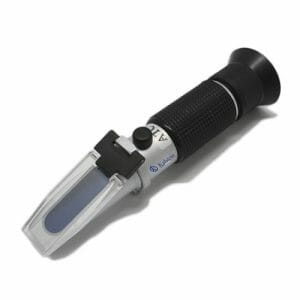Refraction is the change in the speed of light as it passes from one medium to another, which is manifested by the variation that occurs in the wave as it passes through the media (gaseous, liquid, solid). Light travels in different materials at different speeds, making the refractive index a specific physical property. The formula behind the phenomenon is described with the Snell Law, which is used to describe the relationship between the angles of incidence and light.
The refractive index is the ratio of the speed of light in the air to the speed of light of the substance being tested. The measuring instrument associated with this parameter is called a refractometer, able to measure with great precision up to 5 significant figures and is a very important equipment used to characterize solutions. Since the late nineteenth century, refractometry has remained one of the most used techniques to quantify concentrations in mixtures.
One type of refractometer commonly used is the portable, they are small (handheld) and practical, easy to handle ideal for both laboratory and field work, these can be analog or digital and are calibrated to measure the concentration in degrees Brix.
Applications of the Refractometer
- Determination of mixing compositions.
- Quality control of products.
- Control of quantities of substances.
- Determination of maturity in fruit crops.
- Standardization of processes.
Method of measurement with a portable refractometer
- Hold the refractometer with your fingers, be careful not to take it with the palm of your hand. Put one or two drops of sample on the prism.
- The sample should be evenly distributed over the prism, avoiding the formation of air bubbles.
- Gently close the prism cap.
- Look at the scale through the eyepiece, if the equipment does not have LED you can read in sunlight and focus using the calibration screw until it is clear.
- Read the values where the measurement scale intercedes with the boundary line.
- Clean the sample with a tissue moistened with warm water, then dry thoroughly and store in its case.
Aspects to consider when using the Refractometer
- A known reference wavelength should be used to initiate the assessment, for this it is advisable to filter daylight or use an LED.
- For accurate measurement, working temperature limits must be taken into account.
- Keep the cap and prism carefully clean and dry before each calibration.
- Avoid bumps, drops or scratches that could damage the optic system.
- The refractive index provides information on the purity of a substance, but not on the exact composition of the substance.
- Note that a thermal corrected scale on a refractometer is always specific to each substance and should never be applied in a general way.
Some useful tips for using the Refractometer
- The prism and prism cover must be completely clean before starting the measurement process. Surface debris may cause measurement errors. To avoid such interference, you can clean the sample holder with isopropyl alcohol or dilute neutral detergent. You should clean the prism with warm water (approx. 20°C) after measuring hot samples. It is not recommended to use water below 10ºC. Ideally, you should review the equipment manual.
- As long as you are not using the equipment, it should ideally be kept in its case, in a dry environment, away from direct sunlight.
- Proper sample handling extends prism life. When measuring samples above room temperature, wait for the temperature to cool before placing them in the prism.
- Do not leave the instrument near hot bodies such as mufflers, ovens, pots. HERE
At KALSTEIN we are MANUFACTURERS of Portable Refractometers of 0-10%, 0-32%, 0-50% and 58-92% BRIX. We offer you precision optical instruments with advanced technology, adjusted to your requirements. Visit our website HERE for more information about our products, PURCHASE, SALE and PRICES. HERE




